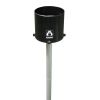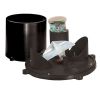HOBO Data Logging Rain Gauge
Features
- Time and date stamp is stored for each tip for determining rainfall rates and duration
- Compatible with HOBOware and HOBOware Pro software for logger setup, graphing and analysis
- Also records temperature when used with an optional solar radiation shield
- Free ground shipping
- Expedited repair and warranty service
- Lifetime technical support
- More
Overview
Record up to 160 in. of rainfall at rates up to 12.7 cm (5 in.) per hour. The Data Logging Rain Gauge system is battery-powered and includes a HOBO Pendant Event data logger with a tipping-bucket rain gauge. Easily collect rainfall, time, and duration data, as well as temperature, when used with an optional solar radiation shield (RS1 Solar Radiation Shield, or M-RSA). A base station or shuttle is required.
Rain Gauge
Maximum rainfall rate: 12.7 cm (5 in.) per hour
Calibration accuracy: ±1.0% (up to 1 in./hour for the RG3 or 20 mm/hour for the RG3-M)
Resolution: 0.01 in. (RG3) or 0.2 mm (RG3-M)
Calibration: Requires annual calibration: can be field calibrated or returned to the factory for re-calibration
Operating temperature range: 0° to +50°C (+32° to +122°F)
Storage temperature range: -20° to +70°C (-4° to +158°F)
Environmental rating: Weatherproof
Housing: 15.24cm (6-in.) aluminum bucket
Tipping bucket mechanism: Stainless steel shaft with brass bearings
Dimensions: 25.72 cm height x 15.24 cm diameter (10.125 x 6 in.); 15.39 cm (6.06 in.) receiving orifice
Weight: 1.2 Kg (2.5 lbs)
Part numbers: RG3 (0.01 in. per tip) ; RG3-M (0.2 mm per tip)
Logger
Time stamp: Resolution 1.0 second
Time accuracy: ± 1 minute per month at 25°C (77°F), see Plot B on page 10.
Operating range: -20° to 70°C (-4° to 158°F)
Environmental rating (for logger used outside of rain gauge): Tested to NEMA 6 and IP67; suitable for deployment outdoors
NIST traceable certification: Available for temperature only at additional charge; temperature range -20° to 70°C (-4° to 158°F)
Battery: CR-2032 3V lithium battery; 1 year typical use
Memory: 64K bytes – 16K to 23K tips when recording rain only; 25K to 30K data points when recording rain and temperature
Materials: Polypropylene case; stainless steel screws; Buna-N o-ring; PVC cable insulation
Temperature Measurement
Measurement range: -20° to 70°C (-4° to 158°F)
Accuracy: ± 0.47°C at 25°C (± 0.85°F at 77°F). A solar radiation shield is required for accurate temperature measurements in sunlight.
Resolution: 0.10°C at 25°C (0.18°F at 77°F), see Plot A on page 10.
Drift: Less than 0.1°C/year (0.2°F/year)
Response time: Airflow of 1 m/s (2.2 mph): 10 minutes, typical to 90%
- Tipping-bucket rainfall collector
- HOBO Pendant Event Logger
- Mounting accessories: two hose clamps, three screws
In The News
Floating Global New Ideas: Buoy-Enabled Research at Florida Agricultural and Mechanical University’s School of the Environment
Florida Agricultural and Mechanical University (FAMU), based in Tallahassee, Florida, is the highest-rated public Historically Black College or University in the United States. FAMU’s School of the Environment (FAMU-SOE) offers BS and BA degrees in Environmental Studies, and BS, MS, and Ph.D. degrees in Environmental Science, with specialisms available in areas including Environmental Policy and Risk Management, Aquatic and Terrestrial Ecology, and Biomolecular Sciences. In 2021, FAMU-SOE deployed a NexSens CB-450 buoy in Apalachee Bay, a key oyster farming area around 30 miles south of Tallahassee. The buoy has quickly been incorporated into the curriculum, providing environmental insights for student research, the community, and beyond. Dr.
Read MoreMonitoring Habitat Suitability and Water Quality in Northwest Arkansas Springs
Northwest Arkansas has seen an economic, industrial, and population boom in recent years as a result of expanding businesses, which have created thousands of jobs in the region and the mass migration of employees and construction companies. However, with this growth has come rapid urbanization and the degradation of the natural landscape, specifically the freshwater springs that can be found throughout the region. These springs are critical habitat centers for native wildlife, home to threatened and endangered fish, and those that have yet to be listed. Zach Moran, Assistant Professor of Fisheries Science at Arkansas Technical University, is working to help monitor these habitats and provide key data that will hopefully inform future development in the region.
Read MoreThree Decades of Research at Acton Lake
A multi-disciplinary team at Miami University, Ohio, has been studying the environmental change at Acton Lake for over three decades. Using three different NexSens buoys over this time, the team has an incredible archive of data that is helping build a picture of Acton’s past, present, and future. Until recently, a NexSens CB-50 buoy was used alongside other environmental monitoring at Acton Lake. In May 2025, the Miami team deployed a new XB-200 buoy , future-proofing their ongoing monitoring using real-time buoy systems. Acton Lake, a small hypereutrophic reservoir in southwest Ohio, covers 2.4km² and has a maximum depth of about 8m. The dam was built in 1956, and the lake has a large agricultural watershed.
Read More














